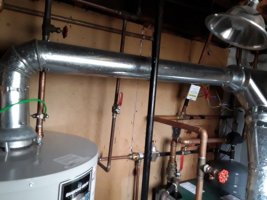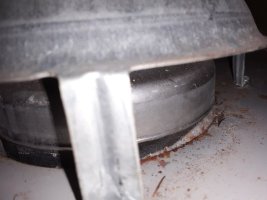Sorry for the long post, but I don’t want to leave anything important out.
Over the weekend, I noticed that our hot water heater back drafts when the furnace is on at the same time. They both vent together to the chimney. Please see attached pictures. The WH (40 gallon – 40,000BTU input) is 4 years old. Our medium efficiency furnace (max input: 105,000 BTU, heating capacity: 86,000BTU) is being used for its 3rd winter season. They were both installed by the same plumbing company. Our previous WH lasted for about 16 years and was either a 40 or 50 gallon (I don’t remember) and our old furnace was from the 1960’s. The ductwork all dates from when the new appliances were put in.
The HW heater and furnace are located in a small utility room in the basement (approx 35 sq ft) but the door to it is ALWAYS left completely open and leads into a 200 sq foot room. Next to that room is an even larger room (which is not sealed very well despite my efforts), and the door between them is left open about halfway. We have no other appliance or fixture in the house which vents besides for the dryer which is not used for more than a couple hours a week, and has not been used since last Wednesday.
We have a CO detector in the 200 sq foot room, about 15 feet from the WH and 10 feet from the furnace. It has never gone off. Neither has the one outside our bedrooms on the 2nd floor of the house.
When I entered the utility room on Friday, I happened to look at the top of the WH and noticed some drops of water on it. I then noticed some rust as well. This covers an area about 1/4 of the circumference around the vent opening. The rest is all free of rust. (Maybe this is because the vent hood is centered imperfectly.) I read that this could be a sign of back drafting. My husband and I discovered that when the WH is on by itself, there is no issue and the air goes straight up the vent. But when the furnace is on as well, there is a back draft. My husband tested this with a lighter, and he couldn’t even light it anywhere near the area, the air would put it out. When the furnace is on by itself, everything seems fine. Certainly no air back drafts down the WH.
We see no other visible signs of a problem. The window in the room and the water pipes don’t have condensation. I don’t see rust on the top of the furnace.
Is there anything about the ductwork that looks amiss? Is it possible we don’t have enough air for combustion even though that room opens up into a much larger one?
One possible explanation for our situation, is that there may be a partial blockage in the chimney. Probably dating from when the new furnace was put in, although it could be from a couple years before that when the old one was serviced, my husband was able to see into the chimney from the basement (the plumber had detached the venting) and he said that he saw some debris inside, similar to the floor of a constructions site, but the airspace seemed unobstructed. We also had someone from a chimney company some months ago go on the roof of the house because we had had it repointed, but still occasionally when we have a rainstorm with wind from a particular direction, a small amount leaks into the attic. He doesn’t know for sure what is causing this but he did say that the chimney liner, which is made of (ceramic) tiles, has some joints where the mortar is missing. He was looking only with his eyes so of course he couldn’t see very far down.
If the furnace indeed has no problem and is operating properly, could it really be that there is enough air space in the chimney for the furnace gases but when combined with the WH gases, there is not enough room, and those back draft? My husband is of the opinion that the WH produces a lot less gas than the furnace. On the other hand, if we have had this problem since the furnace was installed 2+ years ago, would we not have even more rust on the WH?
Any help would be much appreciated. We certainly don’t want to go through the expense of having the chimney relined when it is not responsible for this issue. And if we called in the plumber, we would more than likely just be paying him to say that there is no problem and that he did everything correctly.
Over the weekend, I noticed that our hot water heater back drafts when the furnace is on at the same time. They both vent together to the chimney. Please see attached pictures. The WH (40 gallon – 40,000BTU input) is 4 years old. Our medium efficiency furnace (max input: 105,000 BTU, heating capacity: 86,000BTU) is being used for its 3rd winter season. They were both installed by the same plumbing company. Our previous WH lasted for about 16 years and was either a 40 or 50 gallon (I don’t remember) and our old furnace was from the 1960’s. The ductwork all dates from when the new appliances were put in.
The HW heater and furnace are located in a small utility room in the basement (approx 35 sq ft) but the door to it is ALWAYS left completely open and leads into a 200 sq foot room. Next to that room is an even larger room (which is not sealed very well despite my efforts), and the door between them is left open about halfway. We have no other appliance or fixture in the house which vents besides for the dryer which is not used for more than a couple hours a week, and has not been used since last Wednesday.
We have a CO detector in the 200 sq foot room, about 15 feet from the WH and 10 feet from the furnace. It has never gone off. Neither has the one outside our bedrooms on the 2nd floor of the house.
When I entered the utility room on Friday, I happened to look at the top of the WH and noticed some drops of water on it. I then noticed some rust as well. This covers an area about 1/4 of the circumference around the vent opening. The rest is all free of rust. (Maybe this is because the vent hood is centered imperfectly.) I read that this could be a sign of back drafting. My husband and I discovered that when the WH is on by itself, there is no issue and the air goes straight up the vent. But when the furnace is on as well, there is a back draft. My husband tested this with a lighter, and he couldn’t even light it anywhere near the area, the air would put it out. When the furnace is on by itself, everything seems fine. Certainly no air back drafts down the WH.
We see no other visible signs of a problem. The window in the room and the water pipes don’t have condensation. I don’t see rust on the top of the furnace.
Is there anything about the ductwork that looks amiss? Is it possible we don’t have enough air for combustion even though that room opens up into a much larger one?
One possible explanation for our situation, is that there may be a partial blockage in the chimney. Probably dating from when the new furnace was put in, although it could be from a couple years before that when the old one was serviced, my husband was able to see into the chimney from the basement (the plumber had detached the venting) and he said that he saw some debris inside, similar to the floor of a constructions site, but the airspace seemed unobstructed. We also had someone from a chimney company some months ago go on the roof of the house because we had had it repointed, but still occasionally when we have a rainstorm with wind from a particular direction, a small amount leaks into the attic. He doesn’t know for sure what is causing this but he did say that the chimney liner, which is made of (ceramic) tiles, has some joints where the mortar is missing. He was looking only with his eyes so of course he couldn’t see very far down.
If the furnace indeed has no problem and is operating properly, could it really be that there is enough air space in the chimney for the furnace gases but when combined with the WH gases, there is not enough room, and those back draft? My husband is of the opinion that the WH produces a lot less gas than the furnace. On the other hand, if we have had this problem since the furnace was installed 2+ years ago, would we not have even more rust on the WH?
Any help would be much appreciated. We certainly don’t want to go through the expense of having the chimney relined when it is not responsible for this issue. And if we called in the plumber, we would more than likely just be paying him to say that there is no problem and that he did everything correctly.








